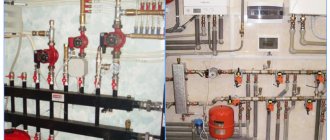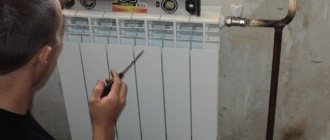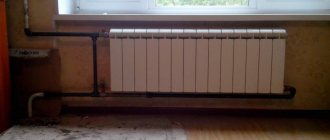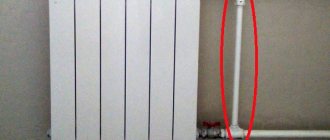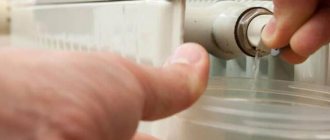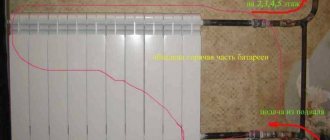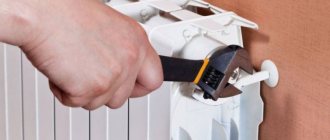Every owner of a private house or apartment with water heating should know how to bleed air from a heating radiator. The thing is that the accumulated air in the radiator becomes an insurmountable obstacle and blocks the flow of coolant.
As a result, the heating radiator ceases to function fully, that is, all or part of its surface ceases to heat up and release heat to the surrounding space.
Airing of the panel heating device (blue color)
To eliminate this phenomenon, you need to bleed the air from the battery. How to do this in a timely and effective manner will be discussed in this article. Carrying out such an operation does not cause any particular difficulties if the heating system is assembled correctly, taking into account all the features of water heating of premises. Throughout the heating season, it is necessary to carry out preventive measures of this nature from time to time.
Reasons for airing the system
There are several fairly common reasons that provoke the appearance of an air lock inside heating structures:
- depressurization that occurred during scheduled maintenance or repair work;
- improper flushing or pressure testing of the system followed by filling the water circuit with standard coolant;
- local violation of the integrity of pipelines and radiator batteries under negative external influences or as a result of maintenance and operating errors;
- in private households - the absence of a sufficient pipe slope and expansion tank in the installed system;
- reduced pressure level in the water supply system, filling the resulting voids with air;
- faulty condition of air intake elements;
- connection to the heating structure of a “warm floor” system with pipes of different heights;
- air suction through leaky seam joints and joint areas;
- low quality coolant, oversaturation with gases;
- replenishing the volume of thermal fluid by adding cold tap water.
One of the most common problems is the presence of errors and errors at the stage of creating design documentation or installing pipework.
Installing air release valves
To remove air from heating, air vents are installed on radiators - manual and automatic air valves. They are called differently: bleeder, air vent, bleeder or air valve, air vent, etc. The essence does not change from this.
Mayevsky air valve
This is a small device for manually bleeding air from heating radiators. It is installed in the upper free radiator manifold. There are different diameters for different collector sections.
Manual air vent - Mayevsky tap
It is a metal disk with a conical through hole. This hole is closed with a cone-shaped screw. By unscrewing the screw a few turns, we allow the air to escape from the radiator.
Device for removing air from radiators
To facilitate air outlet, an additional hole was made perpendicular to the main channel. The air actually comes out through it. When deflating using a Mayevsky tap, point this hole upward. After this you can unscrew the screw. Unscrew it a few turns, but do not unscrew it too much. After the hissing stops, return the screw to its original position and move on to the next radiator.
When starting the system, it may be necessary to bypass all the air collectors several times until air stops escaping altogether. After this, the radiators should heat up evenly.
Automatic air release valve
These small devices are installed both on radiators and at other points in the system. They differ in that they allow you to bleed air in the heating system automatically. To understand the principle of operation, consider the structure of one of the automatic air valves.
The operating principle of the automatic release is as follows:
- In normal condition, the coolant fills the chamber by 70 percent. The float is at the top, pressing the rod.
- When air enters the chamber, the coolant is forced out of the housing and the float lowers.
- He presses the protrusion-flag on the nozzle, squeezing it out.
- The depressed jet opens a small gap, which is enough to allow the air that has accumulated in the upper part of the chamber to escape.
- As water comes out, the air vent body fills with water.
- The float rises, releasing the rod. It returns to its place due to the spring.
Various designs of automatic air valves operate on this principle. They can be straight or angular. They are placed at the highest points of the system and are present in the security group. They can be installed in identified problem areas - where the pipeline has an incorrect slope, which is why air accumulates there.
Instead of Mayevsky's manual taps, you can install an automatic drain for radiators. It is only slightly larger in size, but works automatically.
Automatic air release valve
Cleaning from salts
The main problem with automatic valves for venting air from the heating system is that the air outlet hole is often overgrown with salt crystals. In this case, either the air does not come out or the valve begins to “cry”. In any case, you need to remove it and clean it.
Automatic air vent disassembled
So that this can be done without stopping the heating, automatic air valves are installed in pairs with non-return valves. The check valve is installed first, followed by the air valve. If necessary, the automatic air collector for the heating system is simply unscrewed, disassembled (unscrew the lid), cleaned and reassembled. After this, the device is again ready to bleed air from the heating system.
Stub
It is not an easy task to bleed air from a heating battery if there is no air vent and a plug is installed instead. Before starting work, you should block the coolant access to the radiator.
Modern sectional batteries are equipped with top plugs. There is no need to completely remove the fitting. It is enough to carefully turn it slowly, making several turns, and wait until the air comes out. First, all adjacent surfaces should be protected with rags.
It is more difficult to ventilate an old cast-iron radiator, since usually the plug on it is securely fixed with tow and paint. Algorithm of actions:
- Apply a little solvent to the connection between the fitting and the battery. Wait 10-20 minutes.
- Place a bucket under the hole. Place rags on the floor.
- Using an adjustable wrench, unscrew the plug (not completely) until air begins to escape.
- Wrap the thread with sealing material and tighten the plug.
Bleeding air from an old cast iron radiator may require more effort
It is important to do everything carefully. If you do not turn off the water and remove the fitting completely, hot water under pressure will flow out of the hole.
You can determine that the air lock has been eliminated by assessing the temperature of the batteries. Sections that were previously cold should warm up.
Tap
Many old batteries have regular water taps. When you unscrew the valve, water begins to flow from the hole, and with it the accumulated air comes out. You may need to drain several buckets of liquid to remove all the excess gas.
To make the work easier, it is advisable to use a long flexible hose: attach one end to the tap, and lower the other end into the toilet. The valve must be opened as much as possible to ensure a high flow rate of water.
How to understand that the battery is airy
Signs of air locks appear immediately. Here you don’t need to be a great specialist to understand that it is necessary to get rid of air in the heating radiator by bleeding it.
Cold areas of the battery indicate the presence of air.
You can recognize the airing of the heating by the following signs:
- Air serves as a kind of heat insulator. In the place where it accumulates inside the battery, the sections are not heated by the coolant. The areas can be easily identified by touching the radiator with the palm of your hand.
- The presence of air will be indicated by gurgling in the radiators when the heating is on.
- Autonomous heating of a closed type is equipped with a pressure gauge. If the measuring device shows a drop in pressure in the system, then it does not occur without a special reason. Probably, a leak appeared somewhere due to depressurization of the unit. Naturally, as the coolant flows out, air penetrates into the system.
If one of the reasons appears, you need to bleed the air from the radiator in the apartment, after which the heating will be restored.
Important! The reason for the battery cooling may be that one of the supply pipes is clogged with rust or dirt. If, when draining from the Mayevsky tap, a strong stream of water flows without pops of air, then the problem is not airing.
How to bleed air from different types of batteries
Based on the material of manufacture, space heating devices are divided into a number of types of batteries with their own characteristics of air bleed - these are radiators:
- aluminum;
- steel;
- bimetallic;
- cast iron;
- copper;
Aluminum
Heating devices made of aluminum are made by extrusion of molten metal. That is, liquid aluminum is pressed into the flask. The material of the radiators is quite soft and deforms at the slightest mechanical impact. For this reason, aluminum batteries are recommended to be installed in private houses with autonomous heating systems equipped with automatic air vents.
Steel
Batteries made of steel are very durable. Therefore, they easily tolerate the installation of both Mayevsky cranes and automatic machines. Sometimes both are replaced with thermostats.
Bimetallic
Radiators that have a steel body covered with aluminum alloy fins are most often equipped with Mayevsky taps. Bimetallic devices are installed in private mansions and apartment buildings. Depending on local heating conditions, the radiators are equipped with automatic air discharge devices.
Cast iron
The peculiarities of cast iron, as a brittle material, force one to be careful when choosing devices for releasing air pockets. Basically, as mentioned above, conventional taps or mortise bolt valves are used.
Copper
This expensive, but excellent in its thermal conductivity, metal requires delicate handling. For copper radiators, special devices are used, built on the principle of the Mayevsky tap. The condition for inserting devices made of the same metal as the radiator itself is met - copper.
All these features of installing devices for bleeding air from batteries made of various materials do not depend on their design, whether they are sectional, tubular, panel, plate or vacuum devices.
The danger of air jams
Such air congestion significantly reduces the heating efficiency of heating devices, which negatively affects the overall temperature in the apartment.
The most obvious sign of a traffic jam is gurgling, knocking, or babbling in the pipes when water is poured into the heating pipes. For owners of private houses with heating boilers, if you hear such sounds, bleed the air from the radiators, otherwise this will lead to damage to the boiler. If the heating of the battery surface is uneven, lightly tap the battery surface with a metal object. In those places where air accumulates, the sound of the impact will be loud and resonant.
Prolonged contact between the battery metal and the air inside leads to corrosive deposits, which will then cause the device to fail. These are the main reasons why it is advised to bleed the air from the battery as quickly as possible.
Mechanical hand taps
They are used in apartments, private houses, office and industrial buildings. Suitable for both autonomous heating systems and centralized heating systems. The design of just such a crane is discussed above.
In a mechanical manual faucet, to bleed air, it is enough to turn the shut-off screw half or full, less often 2-3 turns counterclockwise.
To unlock and lock the valve, the free end of the locking screw is performed:
- With slot for using a mechanic's screwdriver.
- With square head.
- With a combined head designed for both a wrench and a screwdriver.
- With thumb grip or lever.
Expert opinion
Grebnev Vadim Savelievich
Heating system installer
The main criterion when choosing a particular design is ease of access.
Heating system without air locks
To ensure that air in an individual heating system does not accumulate in problem areas, but goes outside, it is necessary:
- correctly design and install the pipeline, correctly install radiators;
- use automatic and manual air vents.
Let's look at how to expel air from a heating system with natural circulation and top wiring
When arranging a pipeline, it is important to maintain an inclination angle at which air bubbles move freely upward, to the highest point of the circuit, without accumulating at turns and flat areas. At the highest point of such a system, an open-type expansion tank must be installed, through which air bubbles enter the atmosphere
Bleeding air from the heating system using an automatic air vent
To bleed air from a system with forced movement of coolant or a gravity system with bottom wiring, a different principle is used
. Return pipelines are installed at a slope (this simplifies draining liquid from the system), and at the top point of all individual circuits, automatic valves are installed through which air is discharged as it accumulates.
In addition to automatic air vents, the system also uses manual Mayevsky valves. Such air vents are mounted on heating radiators - on the upper pipe on the opposite side of the pipe supplying the heated coolant. To ensure that air enters the valve and does not accumulate in the upper radiator manifold, it is recommended to install the heating device at a slight angle. Air release is performed manually as needed.
How to find an air lock?
Ideally, the system independently copes with airing thanks to automatic valves through which air is released. If you discover that a particular heating device or part of the circuit is not working properly, you need to find the place where the air has accumulated.
Touch the radiator - if its upper part is colder than the lower part, it means that coolant is not flowing there. To release air, open the Mayevsky valve installed on a steel, aluminum or bimetallic radiator, or the valve valve mounted on cast iron batteries.
How to determine the air lock in the battery
You can also determine the place of airing by sound - under normal conditions, the coolant moves almost silently, extraneous gurgling and sounds of overflow occur due to an obstacle in the flow.
Metal pipes and heating appliances are tapped with light blows - in places where air accumulates, the sound is noticeably louder.
Getting rid of the airlock
If there are manual air vents on radiators, there are no problems with how to remove air from the batteries. Using a screwdriver or a standard wrench, the stem of the Mayevsky tap is slightly unscrewed, and a suitable container is placed under the drain hole (a half-liter glass jar is enough). Bleeding air from the heating system using a manual air vent is accompanied by hissing and whistling, then splashes appear, after which the coolant begins to flow in a thin stream. At this stage, the Mayevsky tap should be closed.
To remove an air lock from the heating system if it has accumulated away from the air vent (manual or automatic), proceed as follows
:
- Open the air tap or valve closest to the air bubble.
- They begin to gradually replenish the system with coolant so that the liquid, due to an increase in volume, displaces the air bubble towards the open air vent.
Automatic air vent valve with corner connection
What to do in difficult cases when adding more coolant volume does not remove the plug? In such a situation, in addition to increasing the amount of coolant, it is necessary to add pressure, heating the liquid to critical temperatures. You should act extremely carefully so as not to be scalded by the splashes that accompany the release of air through the automatic valve.
Some nuances
There are situations when craftsmen, when installing a heating system, do not install special valves to release excess air.
Let's look at how to bleed air from a heating battery in this case. To work, you will need an adjustable or gas wrench. Use it to unscrew the plug. This needs to be done very slowly. Sometimes the plug won't come off. Most often this happens if the battery is cast iron. In this case, you need to apply a special lubricant to the threads and try again after some time. When the plug is unscrewed, the same algorithm of actions is performed as with a regular tap. When the plug is screwed into place, you must remember to wrap either FUM tape or flax around the thread. This will avoid leaks and make the connection tight.
This container is always located at the highest point of the heating system. When the water is drained, you need to wait a little and then unscrew the tap on the expansion tank. Usually, when the battery temperature rises, the plug comes out on its own. If such actions are unsuccessful, then the water in the circuit should be brought to a boil. In this case, the plug will definitely come out.
How often should I bleed?
Knowing how to bleed air from a heating system can prevent and solve many problems.
But how often should such a procedure be carried out for preventive purposes? As a rule, this should be done at the beginning of the heating season. Twice is enough (the first time for checking, the second for control). Of course, if the system has defects or is faulty, then the number of descents may be greater. If the apartment has aluminum radiators, then before starting the system it is necessary to drain the water. This will help increase battery life significantly.
Preventing the formation of air pockets
You can avoid the appearance of air in the heating system even at the very initial stage of its startup. To do this, it is necessary to correctly fill the pipes and batteries with coolant. In open systems this is done in the following way:
- We open all the valves to ensure unhindered movement of the coolant;
- Leave the drain valve closed;
- We begin to carefully fill the system with water.
Please note that the pressure is not very high. When filling a closed heating system, bleed air in the following way:
When filling a closed heating system, bleed air in the following way:
- We connect a pressure test pump, which allows pumping stable pressure in the heating;
- Close the taps on the radiators;
- We are waiting for the system to fill up.
Despite its apparent simplicity, the Mayevsky crane is an extremely effective tool that perfectly performs the task.
Now you need to fill the batteries with water and get rid of the air using Mayevsky taps. We sequentially go around all the heating devices, carefully open the valves, let in the coolant, remove air masses using the above taps, after which we close the valves. The pressure in the pipes must be maintained at one atmosphere, so it is more convenient to perform the operation together. At the final stage of work, we turn on the heating, wait until the set temperature is reached, and then repeat the procedure with the batteries.
Good radiators, for example, steel or bimetallic, will help prevent the appearance of air in the heating - in them the likelihood of air jams forming is reduced to almost zero
When carrying out installation work, it is necessary to pay attention to tightness, carefully and completely tightening all connecting parts. It is also recommended to install automatic or manual air vents.
One of the air vents is installed at the highest point, since air in radiators and pipes tends to accumulate in the upper parts of heating systems.
What to pay attention to
Each heat exchanger has a release valve, which is usually located in the upper left or upper right corner of the heater. Install the key and turn counterclockwise. You must be slow and careful as there is pressure in the heating system. After a while, a hissing sound may appear. This means that air is being removed from the battery.
Water will start to come out of the heat exchanger, so you must remember to place a container or container underneath it. After a while, only water will come out of the valve. Then it should be turned back clockwise.
Those who have never done this themselves should pay special attention to safety: the water that comes out of the radiator can be very hot at some point. There is even a risk of scalding
Cast iron batteries
The Mayevsky crane simplifies the work, but not all batteries have such a convenient device. For example, on cast iron versions you can often find a regular plug screwed onto tow and coated with paint. Removing it is problematic. Of course, you can visit the neighbors below or above, who have a Mayevsky tap on the radiator - this way you can gain access to the coolant. But this is not always possible.
We'll have to resort to the "old-fashioned" method. You will need a basin, a bucket and a lot of unnecessary rags. You don’t even have to try to unscrew the plug with your bare hands; you need to take an adjustable wrench. A paint thinner will also come in handy; the plug must have dried firmly over a long period of time. Then follow the instructions:
- Apply solvent to the plug and wait twenty minutes.
- Run along the thread with an adjustable wrench until the plug gives way. You should hear the sound of air escaping.
- When the sound dies down, you need to wrap a new layer of “fumka” around the plug and insert it in its original place. If necessary, touch up the joint.
In order not to worry about heating the room in winter, you just need to promptly remove air pockets that interfere with the normal movement of the coolant. The result will be a warm, cozy atmosphere in the house even in the most severe frosts.
Correct option
To carry out a successful operation, an adjustable wrench is a must, as well as a basin and rags. You will need to purchase tow, FUM tape or sealant. It is imperative to shut off the coolant supply. The following steps are performed sequentially:
- First, remove the tow, but first place a container under the radiator. If you can’t get to the tow right away, then remove (dissolve) the paint.
- Carefully, slowly unscrew the plug. Any sudden movements or great efforts are avoided, because there is always a risk of breaking the thread.
- If the element does not lend itself, then use a solvent or WD-40, a rust converter. The product is poured into the problem joint.
- Then they pause: wait 5-10 minutes. Then they repeat the steps, also carefully. The operation is stopped when an extraneous sound appears.
- After unscrewing the plug, the air masses begin to gradually bleed off, this process is always accompanied by hissing.
- At the end of this stage, approximately 3-5 liters of water are drained. These actions will minimize the chance of encountering a traffic jam again.
Then the plug is screwed tightly again, having previously wound a new portion of tow. It can be replaced with more modern products - FUM tape. However, they believe that the best option is a combination of these materials. But the shrinking tape has a competitor: they often prefer to coat tow with sealant rather than wrap it with fumigation. For example, UNIPAK sealing paste.
After these manipulations, open the coolant supply valve. Since this method is very complicated, if you lack the skills, it is better to call a specialist, since a leak can be very expensive for the owners. Any master plumber, on the contrary, is well aware of how to bleed air from a battery.
Unsafe express method
If the radiator has been standing since “antediluvian” times, then it is quite possible that the owner will not be able to cope with unscrewing the plug on his own. In this case, some recommend an original method - drilling a hole in it.
To do this you will need a drill, a screwdriver and a metal drill (maximum diameter 4 mm). You also need to find a self-tapping screw; its diameter should be 1.5-2 mm larger than the hole. You will need a rubber gasket under it. To ensure the reliability of the “hot spot”, it is recommended to use a sealant.
The work itself is simple, but must be done quickly.
- First, drill a hole, then carefully and slowly pull out the drill.
- After this, the air will come out and water will begin to flow, quickly screw in the self-tapping screw with the gasket on it.
They say that pre-coating this structure with sealant guarantees almost one hundred percent reliability of the system. If the owner has a desire to test this “maximum”, then he is a person who is not afraid of possible consequences.
In a private house
Many houses have radiators with a Mayevsky tap, so when airing the system, you can use the same method as in an apartment building.
However, usually such devices are not available, which is why the only way is to drain through the expansion tank. Such a device is a mandatory element of any heating system in the house. It can be open or closed. The first option is easier to operate, and airing the system usually means lowering the water level in the tank. To eliminate the problem, it is enough to replenish the missing amount of fluid.
If the heating system has a closed tank, the only solution to the problem is to bleed air through the radiators. Before doing this, it is recommended to try to completely fill the system so that at least 10 liters of water flow out of the control pipe leaving the tank.
After this, you need to start the system again. If the problem persists, it is recommended to bleed air from the battery, following general recommendations. It is worth noting that in old-style heating systems, air may appear in the radiators during intensive operation of the heating boiler.
This is especially often observed when installing solid fuel models without a built-in thermostat. The water heats up excessively, begins to boil and pours out through the control pipe of the expansion tank. As a result, it becomes empty and, if there are cracks that break the tightness, air masses begin to enter the system. Then you can bleed the air using any of the listed methods, but before doing this, you need to eliminate the holes or cracks. Otherwise, the descent will have to be repeated regularly.
Automatic taps with safety valve
In addition to the functions of an air vent, such devices take on the function of protecting elements of heating systems from increased pressure (water hammer).
Automatic taps with safety valve
Such fittings are used in systems where other water hammers are a frequent occurrence, or in cases where the equipment is highly sensitive to it (for example, in heating circuits and on the lines of their polyethylene pipes).
Expert opinion
Grebnev Vadim Savelievich
Heating system installer
The safety valve is activated when the pressure in the line is above a threshold value (usually set to a pressure of 15 MPa).
Removing a plug in autonomous heating
A simple and effective method that allows you to quickly remove air from the system is to install an automatic air collector. The structure is located at the top point of the system. When necessary, it is opened and the air lock is removed.
The simplest means of de-airing is opening the air collector
Another way to bleed air is through an expansion tank . It is usually at the top. To eliminate air from the pipes, no additional actions are required - it rises and goes out on its own.
The air from the heating batteries is vented using a tap installed on the side of the radiator. You can also use a special device - the Mayevsky crane.
The final choice of deaeration method is influenced by the specifics of the project. In general, if the heating technology is followed, there should be no problems.
What is it and what is it for?
This is a shut-off valve of a very simple and reliable design for releasing air from a closed system, manually controlled. It has existed for almost ninety years and is used almost in its original form to this day.
Its other names are: radiator needle air valve, air bleed valve, the most common is the Mayevsky valve. In textbooks, the name radiator needle air valve is usually used.
Deaeration of a centralized system
In apartment buildings and the private sector, central heating is designed with air collectors. They are located at the top point. When the heating system is aired, just open the tap. When an air lock forms, opening the air collector allows air to rise through the pipes. Thus, the entire system is filled with water, and there are no plugs left.
In apartments, to ventilate the system you just need to open the tap
In an apartment or house, you can remove the blockage by bleeding the air in the place where it formed. For this purpose, batteries are equipped with taps. It must be borne in mind that it is unacceptable to install plumbing elements. Special valves called air vents are used . If the owner of the premises installs a water tap instead of an air vent and accidentally drains a certain amount of coolant from the system, he will have to pay a fine.
The vent is opened using a special key or a regular screwdriver. Extreme care must be taken, but even if everything is done correctly, it is possible that not only air will come out of the radiator, but water will also leak out.
How to bleed air from a heating system?
If the coolant is driven by the circulation pump, it is turned off. At least 15 minutes must pass between stopping the equipment and starting to bleed air. During this time, oxygen will rise up.
Prepare a container that will be needed to collect water. Using a screwdriver, wrench or turning the handle, unscrew the tap until a characteristic hissing sound is heard - a sign that air is leaving the system. However, simply waiting for the hissing to stop is not enough. The water needs to flow. This means that the traffic jam has been removed. The stream should be smooth and flow without interruptions. Only after this the valve is closed.
Attention! Sometimes, even after repeated bleeding, air pockets still form. Then the cause may be a breakdown or insufficient twisting.
If the stream of water is uniform, without interruptions, then the air has been removed
Design and operating principle of manual air valve
The needle manual air valve is also called a Mayevsky valve. His device:
- Brass body (plug) with external thread 1/2// or 3/4// for connection to the radiator. The case has two holes for air release Ø 2 mm - one at the end of the case, the second on the side wall;
- Brass locking screw. On one side of the screw there is a groove for a slotted screwdriver, on the other side the screw is machined into a cone that closes the air hole (the “closed” position);
- Plastic casing.
On sale you can find the so-called “faucet at hand”. To use it, you don’t need a key or a screwdriver—the plug can be easily unscrewed by hand.
To remove air from the housing, you need to unscrew the screw. To do this, you can, of course, use a screwdriver, but there are special keys that are most often included. After several revolutions, the screw cone comes out of the end hole and air enters the housing cavity, which is immediately released through the second side hole. The main thing is not to rush to turn off the tap. About 30 - 40% of the air should come out with water, so you need to stock up on time, a basin and rags. After the air has been released, the lost water must be added to the system.
Installation
Modern aluminum or bimetallic heating radiators already have a hole for installing a Mayevsky tap.
It can be found on the side opposite the coolant supply, from above. Most likely, there is already a nut for installation there. There is a plastic plug screwed into it. After its removal, an air valve is installed in this place. Before this, the tap threads must be sealed with a rubber or silicone gasket. Installing a Mayevsky crane on a cast iron battery is much more difficult. Let's start with the fact that these valves are much more powerful than those on aluminum radiators - they can withstand pressures of up to 16 atmospheres and temperatures of 150 C°. Sequencing:
- Drain the water from the radiator;
- Cut a hole in the top plug of the cast iron battery and cut a thread that matches the external thread of the air vent;
- Screw in the Mayevsky tap;
- Add water to the system.
Malfunctions and ways to eliminate them
If the faucet malfunctions, a leak appears. There may be several reasons for this:
- Manufacturing defects. One in fifty taps does not hold pressure at all. The only way out is replacement;
- The screw is too short. In this case, its conical part cannot completely block the hole, so you need to apply a certain force to screw the screw in until it stops;
- Solid particles of debris falling between the screw and the housing can damage the internal threads. Fum tape can help here once, but later you will still have to change the tap.
Installation of Mayevsky cranes
The design of the Mayevsky crane ensures simple installation that any home craftsman can handle.
In this case, you should adhere to some recommendations:
- Mayevsky taps are installed during installation of the system. If the system is already in operation, it is better to install the devices in the off-season, when there is no coolant in the lines and radiators. It is also possible to install taps during the heating season. To do this, you need to turn off the coolant supply to the radiator and drain up to 1/3 of the liquid from it.
- Air vents are installed at the highest points of the heating system, on all radiators and heated towel rails.
- Install the taps into the top holes of the radiators.
For installation, select a hole in the radiator on the side opposite to the heating main entry point. This rule applies regardless of the pipe connection - upper or lower.
To install the Mayevsky tap into the radiator, it is enough to perform only 2 steps:
- Unscrew the radiator cap (plug).
- Screw an air vent with the appropriate diameter into the hole.
The design of the Mayevsky tap provides sealing gaskets, so it does not require additional seals during installation. If desired, you can apply technical flax or fum tape to the thread.
When installing on cast iron radiators you will have to:
- Unscrew the plug.
- Drill a hole in it for threading.
- Cut the thread with a tap.
- Screw in the plug.
- Install the Mayevsky tap.
Expert opinion
Grebnev Vadim Savelievich
Heating system installer
The hole in the plug is drilled from the inside, and the entry when cutting the thread is made from the outside. The plug has a left-hand thread, and the valve body has a right-hand thread. Accordingly, when installing the tap, be sure to secure the radiator cap with an adjustable wrench.
An important condition when installing a tap is the correct location of the outlet. It needs to be oriented downwards or at least turned away from the wall
When installed on heated towel rails, the air vent is installed in the tee.
Recommendations for selection
The most important recommendation is that you should not buy valves made in China. Almost all models of this origin are of dubious quality. The consequences of such savings can lead to the following:
- In parallel with the air pockets, the device will leak liquid. This leads to a drop in pressure in the circuit, as well as to the appearance of leaks on the body, walls and floor.
- A poor quality air vent may simply not work.
- The coolant quickly renders all structural elements of the valve unusable.
With mechanical devices, this problem occurs much less frequently, since there is practically nothing to break in their design. These products are not some kind of complex equipment, so their cost is quite low. Even well-known manufacturers (for example, Valtec) provide products at an average price. Spirotech machines are also famous for their high quality characteristics. Basic tips for choosing:
- It is better to buy a mechanical valve with a plastic or metal handle. This eliminates the need to fiddle with different wrenches or screwdrivers. It is convenient to use the device even in places where access is difficult.
- If there are small children in the house, then it is advisable to install a regular manual faucet, designed for adjustment with a screwdriver. A child can unscrew the vent with a handle and get scalded by the coolant.
- It is recommended to buy devices with an automatic cut-off.
- 4. If your budget allows, you can purchase a device with additional functions. This makes operating the system more convenient.
- The special anodized coating of the valve plays virtually no role. It only reduces the degree of metal corrosion.
On the market you can find combined designs that are also equipped with a vent. These include balancing valves, various shut-off valves, and circulation pumps. Most experts do not recommend using such products. It is better to purchase each part separately. The ROBOCAL valve is perfect for an ordinary apartment. It is designed for pressures up to 6 bar.
Device
A shut-off valve consists of a body with a hole on the side for air to escape and a conical screw that screws into it.
A fully tightened screw seals the hole in the faucet. The housing has a thread for screwing into a radiator cap or pipe with internal thread. A seal is placed on the housing to seal the connection. Typically, the material used for the faucet is brass. Steel products are practically never found.
Prevention methods
In order not to constantly bleed air from the radiators, it is necessary to perform all actions correctly when starting the heating system. The open type of system provides for independent filling of pipes with coolant. To do this, open all the valves, ensuring the unhindered movement of water.
The pressure should not be too great. It is recommended to pay attention to the drain valve, which must be closed when filling the radiators. If the heating system is closed, the algorithm is slightly different. The first step is to close all the valves except the one that starts the water. Next, you should connect a pump that ensures stable pressure in the pipes. The next step is to fill the system with coolant. Only after this should you bleed air from the radiators using a Mayevsky tap.
Air in the radiator is a common problem in houses and apartments , preventing normal heating of the room. If you follow the recommendations of specialists, an ordinary person without professional skills can cope with it.
Advice from professionals
A few tips from professionals will help you safely ventilate the system and reduce the likelihood of blockages:
- Always add water to the cooled autonomous heating circuit from the lowest point under low pressure. After topping up, turn on the boiler, heat the coolant to a temperature of 60 °C, and begin to bleed air from each battery through the Mayevsky valve. If necessary, after servicing all radiators, add more water to the system.
- The rod from the Mayevsky tap cannot be completely unscrewed. It is difficult and often impossible to screw it back in under running hot water.
- Unscrewing the radiator cap in an apartment is strictly prohibited. Central heating operates under high pressure. If the plug is torn off, all the apartments below will be flooded.
If problems arise with airing, it is best to call a specialist from a service organization who has the right to turn off the riser for repairs even during the heating season.
Select the Mayevsky valve. Advantages and disadvantages.
The market mainly offers taps made of brass. But sometimes you come across valves made of steel. Preference should be given to brass products. The main thing is to choose the right diameter of the valve body. Despite the simplicity of the design of the Mayevsky valve, it has both its advantages and its disadvantages:
Simplicity of design and operation, which ensures the durability of the crane. The Mayevsky crane is small in size, making it possible to install it anywhere. Thanks to its simple design, it is reliable. Low cost.
You have to bleed the air manually. Because of this, the Mayevsky valve is not suitable for large heating systems, as it will take a very long time. Cannot be installed in systems with pressure higher than 1.6 MPa. Try to install valves in every radiator in your apartment (house). This way you will increase the efficiency of your entire heating system.
Safety precautions and preventive maintenance
To avoid injuries and other problems, you need to follow a number of rules when bleeding air:
- The rod from the air valve cannot be unscrewed - the pressure of the heated coolant will not allow it to be screwed back on;
- The body of the tap also cannot be turned out - it is very easy to break the thread, but it is difficult to eliminate the consequences of flooding the apartment;
- The radiator caps cannot be unscrewed even partially - they cannot be returned later, and boiling water pouring out of the radiators will bring a lot of negative emotions (about
Automatic air vent
This is a metal unit mounted on a radiator, which is designed to automatically remove air without human intervention. Inside there is a float and a needle valve. These two mechanisms create the balance of the air vent. In working condition, the body is filled with water, the float is raised, the valve is closed. The resulting air gradually enters the device, the float, under its influence, lowers and opens the valve, which allows the air to escape. These devices are usually installed at the highest points of the heating system, where the largest amount accumulates.
Automatic air vent
These units can be straight or angular, depending on the battery configuration. It is important that the outlet should always point upward.
Automatic corner air vent
The automatic air vent is installed in two ways.
- Direct installation into thread.
- Installation via shut-off valve. This valve allows the air vents to be removed without shutting down the system. They are removed for periodic cleaning, since in a state contaminated with impurities it stops working correctly.
To avoid problems when installing this mechanism, a number of rules are followed. You can only unscrew and tighten it with a wrench, since when using an adjustable wrench, you may miscalculate the force and it will crack. You cannot hold on to the air vent housing during work - it can break.
Automatic air vent on battery
The price of an automatic unit is from 300 to 500 rubles, which is much more expensive than its mechanical counterparts. Well-known companies producing air vents are Danfoss and Wind.
Danfoss automatic air vent
